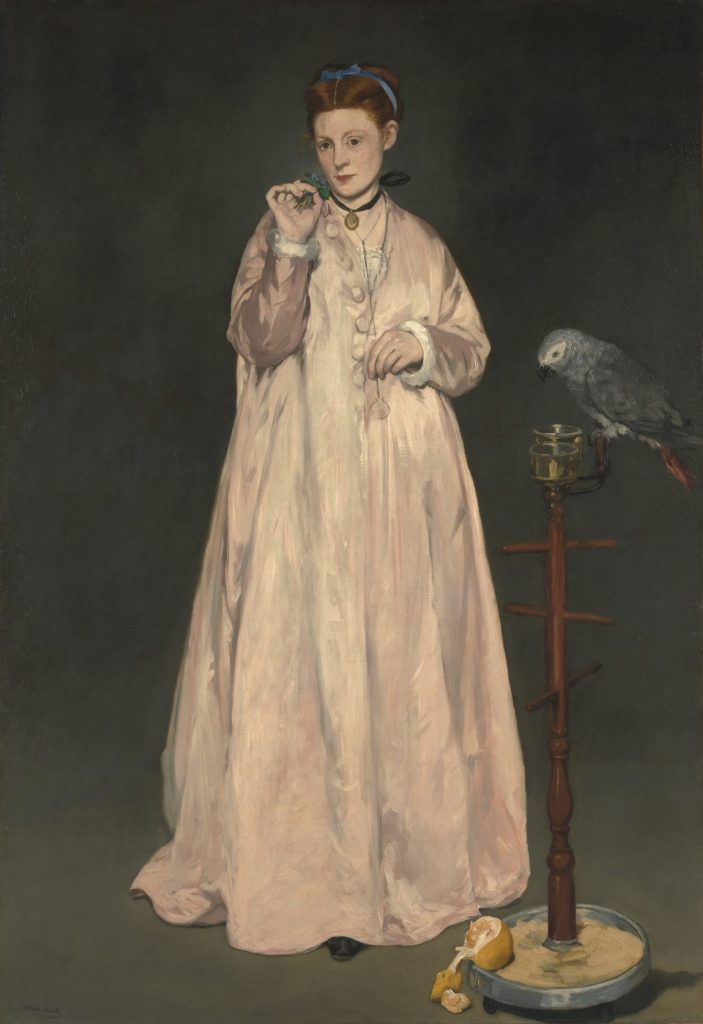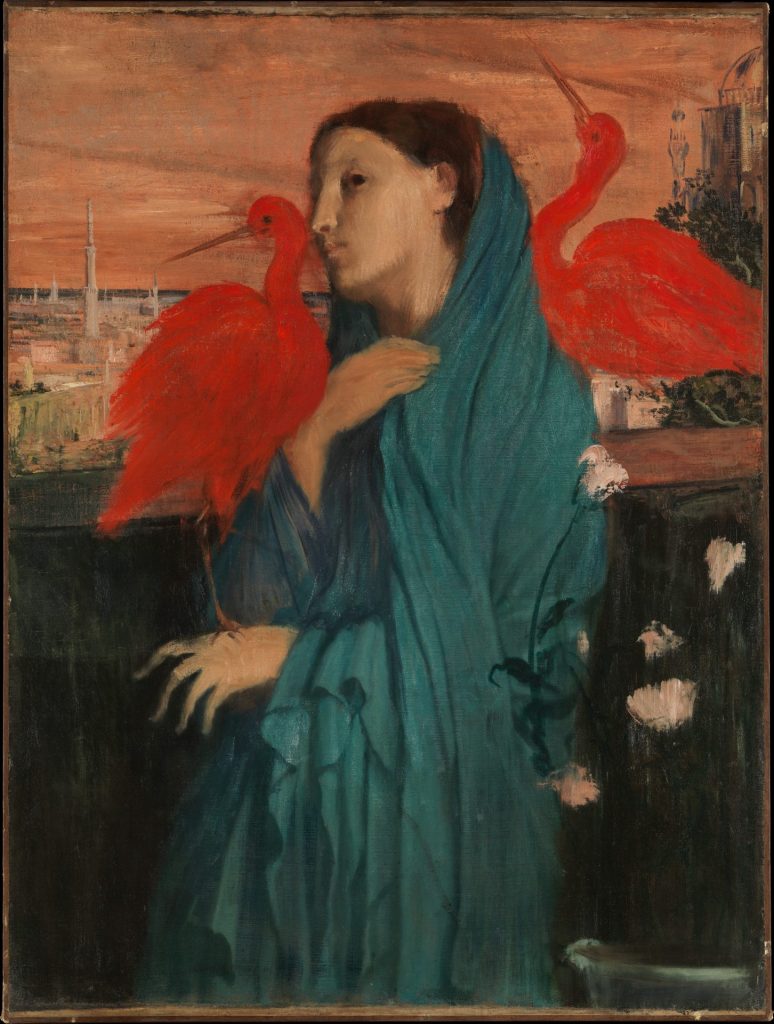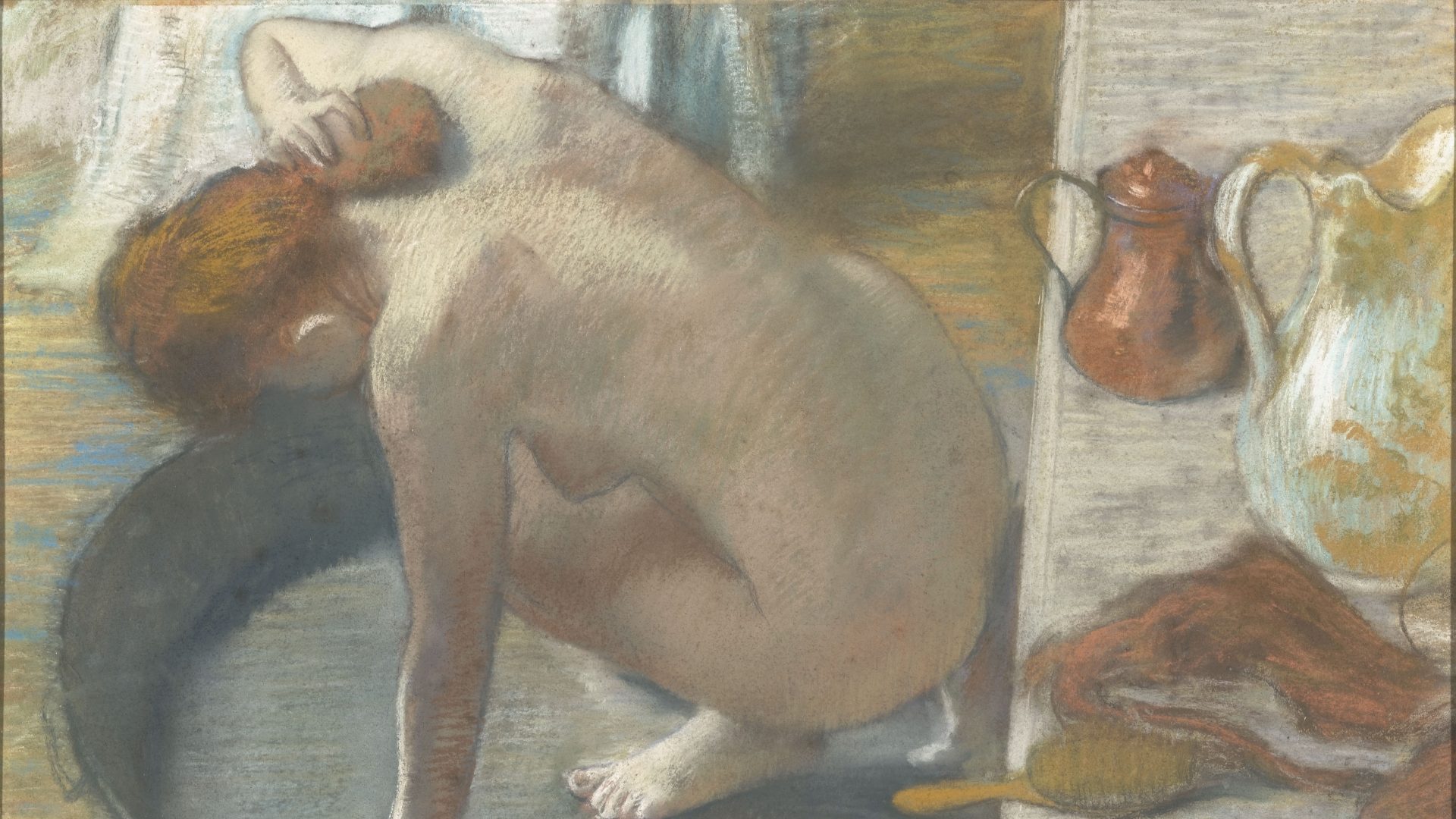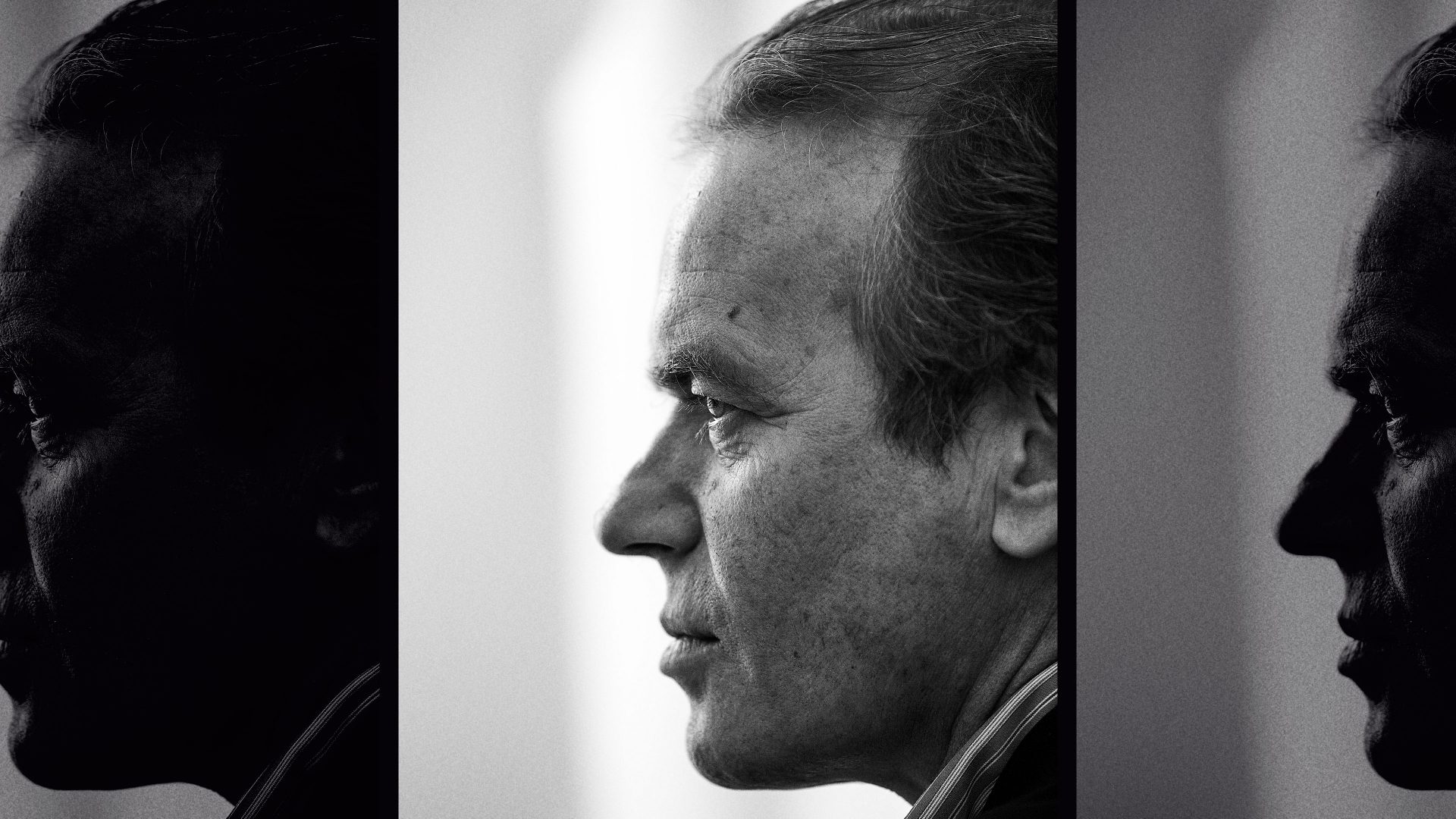According to legend, in the Louvre one day, Édouard Manet (1832-1883) was astonished to discover Edgar Degas (1834-1917) copying Velázquez’s Infanta Margarita directly on to an etching plate. Taken aback by the other artist’s confidence – a mistake made on an etching plate is not easily erased – Manet exclaimed: “What nerve! You’ll be lucky to get away with it, dear boy.”
The apocryphal tale gains credibility in the Musée d’Orsay’s current exhibition, Manet/Degas. Next to Degas’s copy of Infanta Margarita, 1862-4, hangs Manet’s own rendition of the portrait, and it’s easy to imagine Manet, hurrying back to his studio after this thought-provoking first encounter with the artist with whom he would be entangled for the rest of his life.
Complicated might be the most succinct way to describe the relationship between these two uncategorisable modernists, whose simultaneous reverence for and rejection of tradition, mirrored their shared, but differently ambivalent attitudes to the Impressionist movement, with which they were both closely involved and deeply sceptical. The Irish writer George
Moore said theirs was a “friendship shaken by inevitable rivalry”, and in the catalogue, exhibition curator Isolde Pludermacher ranks it as one of the most fascinating relationships in all of art history. “Not easy to define… its
mystery is probably inherent in the nature of the links between the two artists,” she says.
Certainly, they had much in common, from their well-to-do childhoods in Paris to their experiences in the Franco-Prussian war; both travelled in Italy, having abandoned professional careers to pursue their artistic studies, and they shared an appreciation of the art of the past. As children, Degas and Manet were taken to the Louvre regularly: as well as Velázquez (1599-1660), they both admired Delacroix (1798-1863), whose The Barque of Dante, 1822, and The Death of Sardanapalus, 1827-8, among others, scandalised the Paris Salon long before 1863, when the Salon des Refusés championed the rejected offerings of Manet, Courbet, Camille Pissarro, and others.
By the 1870s, the pair were bound, too, by scenes of horse racing, or women in public and in private, reflecting the changing activities of an increasingly urban society, working and at leisure. But for all they had in common, their tempestuous relationship was noticeable, even in the famously mercurial environments of the Café Guerbois and the Café de la Nouvelle-Athènes, where artists and writers including Zola, Fantin-Letour, Renoir and Cézanne were regulars. Pludermacher says contemporaries made much of the contrast between Manet the “born painter”, “elegant, witty, at ease in society”, and the reserved, yet fiery character of Degas, known for his sharp tongue, strong views and disdain for institutions and officials.

Perhaps these temperamental differences partly explain the persistent impression of Manet’s seniority. Though he was only two years older than Degas, he seems to have naturally fallen into the role of mentor, and though he seems not to have deigned ever to make a likeness of Degas, Degas made several portraits of him. In fact, it was one of these portraits, given to Manet as a gift, that was the cause of a notorious row, which erupted after Manet had objected to the depiction of his wife in a double portrait of the couple, and cut her out of the painting.
Degas was also a collector of Manet’s works, especially after the older artist’s early death at the age of 51. By labelling those works owned by Degas, the curators add another strand to the dialogue between the artists. An ambitious joint enterprise between the Musée d’Orsay, the Musée de l’Orangerie, and the Metropolitan Museum of Art in New York, where it will open in September, the exhibition supplements the astonishing riches of its host institution with notable loans from the National Gallery, the Museum of Fine Arts Boston, and the Musée Marmottan Monet, in Paris, among others.
Broadly chronological, the exhibition is organised thematically, in what at times feel like a panoramic walk through the artists’ world. Writing in the catalogue, the director of the Louvre, Laurence des Cars, suggests that seen together, the paintings of Manet and Degas amount to a vivid, and fairly comprehensive sense of the 1860s. Around 200 exhibits including 92 paintings, and 55 works on paper, as well as various letters, are shown in 14 sections that follow the artists as they reflect, and at times seem to track, each other’s activities, as they developed their own distinctive approach.
The most public, and important forum for artists before the advent of art galleries was the Salon, a state sponsored annual event that was an opportunity for artists to secure commissions and publicity, and just as
importantly, to engage with the work of their colleagues. The large gallery
dedicated to the Salon would make a worthwhile exhibition on its own, but
one particularly stunning pairing shows Degas apparently responding to Manet’s La Femme au perroquet (Woman with a Parrot), 1866, which the curators suggest is itself a response to Courbet’s very different painting of the same subject, shown at the Salon of 1866.
With its exotic, fantasy cityscape in the background, Degas’s Jeune femme à l’ibis, 1860-1862, to which Degas is said to have subsequently added two vivid
red ibis in response to Manet’s picture, is rather mysterious, the woman’s timeless blue drapery giving her an ethereal, quasi-religious quality.
In contrast, Manet’s painting at first appears far more traditional; in fact, its prestigious full-length format is a provocation. The woman in the picture is not an aristocrat, but a model, notorious in Paris for having appeared in Manet’s previous Salon offerings Le Déjeuner sur L’Herbe, 1862-3, and Olympia, 1863, each of which had caused a scandal. Her face would have been immediately recognisable, and the tactile fabric of her dress, and the man’s monocle in her fingers, allude to the demi-monde of these earlier paintings.
First shown at the Salon of 1865, Olympia is one of the exhibition’s highlights and a jewel of the Musée d’Orsay, celebrated as one of the highlights of Manet’s career and a pivotal moment as art moved away from mythological, historical and religious subjects to explore the everyday.
In contrast to Woman with a Parrot, Olympia shows a fully naked woman, in the pose associated with acceptable, traditional depictions of Venus. But instead of the coy, averted gaze audiences were used to, Olympia looks directly at us, her black servant and the wrapped flowers bringing a modern
note to the painting to confirm that this is not a goddess, but a prostitute.
As the poet and essayist Paul Valéry wrote some years later: “A scandalous idol, she has all the force of a public exposure of one of society’s wretched
hypocrisies… A bestial Vestal of absolute nudity, she invokes a dream of all the primitive barbarity and ritual animality which lurks and lingers in the ways and workings of prostitution in the life of a great city.”
Also at the Salon that year was Degas, though his painting, a historical episode distinguished by its detailed depictions of violence against women, went largely unnoticed. But it was a turning point for him, too, after which he dedicated himself to more avant-garde subject matter.

In the 1860s, this extended to portraiture which enjoyed great popularity during the second empire (1852-1870). The genre was never a vocation for either of the artists, but they both used it to cement and celebrate friendships and alliances with notable figures of the day, whose support was ever more important as artists increasingly looked further afield for patronage. Still, both artists continued to recognise the importance of the Salon, and Manet in particular seems to have relished the opportunity to participate in the public arena.
Manet’s portrait of Émile Zola was exhibited at the Salon of 1868, and was a public show of gratitude to his childhood friend who had been a loyal and vigorous champion of his works. The writer held that Olympia was Manet’s best painting, and a reproduction of it can be seen on the wall behind him, while the pamphlet he wrote in support of Manet is identifiable by its blue cover.
This striking treatment of a man going about his work is rooted in Renaissance portraiture, but it also owes a debt to Degas’s portrait L’amateur (The Collector of Prints), from two years earlier. The paintings share the sense of a man moulded and immersed in his work, and both frame the subject in a close crop to achieve an intense focus, imposing order on chaotic pictorial fragments by framing them, in the top right of the picture.
Some of the most memorable portraits in the exhibition are of Berthe Morisot, who is honoured with a room of her own, while in London an exhibition dedicated to her alone runs at the Dulwich Picture Gallery until September 10. Morisot made her debut at the Salon of 1864, and is today recognised as one of the founding figures of Impressionism, particularly her impact on Manet – personal, as well as artistic – easily understood from the series of portraits he painted of her, up until her marriage to his brother in 1874. Morisot’s influence on Manet can be seen in the lightening of his palette, and loosening of brushstrokes, especially in scenes of women engaged in private, feminine pursuits such as La Modiste (At the Milliner’s), 1881.
For Degas, such themes were central to his particular brand of Impressionism after the Franco-Prussian war of 1870-1, during which Degas and Manet were both conscripted to defend the besieged city of Paris. By then the leader of the “dissident” group, Degas nevertheless voiced considerable disdain for what the exhibition describes as “an overly sensitive approach to reality”, and these scenes of women’s often hard lives may have seemed to him something of an antidote.
Like Degas, Manet was a distinctly urban artist, with little to no interest in the out-of-doors painting so characteristic of Monet, and Pissarro. But Degas’s depictions of women are considerably darker than Manet’s. His
Interior of 1868-69 is hard to understand as anything other than the prelude or aftermath of a rape (and was titled as such during Degas’s lifetime), next to which the Portrait of Henri Michel-Lévy, around 1878, with its lifeless, slumped female artist’s dummy in the foreground is unforgettably sinister.
Completing the complicated arc of these artists’ intertwined lives, is a very
special loan from the National Gallery, Manet’s The Execution of the Emperor Maximilian, 1867-68. Eye-catching as much for its fragmented state as its brutal subject matter, like Olympia, and Le Déjeuner sur L’Herbe, the Execution commandeers the venerable genre of history painting to launch a vigorous
critique on current affairs. The Emperor Maximilian of Mexico was installed as a puppet of Napoleon III in 1864. But when Napoleon removed his military support, Maximilian was captured by Mexican nationalists and republicans, and executed by firing squad. Manet’s attack on the French betrayal was far too incendiary for the time. When Manet died, it was cut into pieces, which were collected by Degas and acquired by the National Gallery in 1918.
At the time of Manet’s funeral, Degas supposedly said “he was greater than
we thought.” It’s a back-handed, cryptic statement that seems typical of their
bizarre but longstanding relationship, which no amount of speculation is ever likely to elucidate. But by exploring their work together, and highlighting Degas’s considerable collection of some 80 works by Manet, this exhibition is a very special opportunity to piece together their dialogue in pictures.
Manet/Degas at the Musée d’Orsay until July 23. Berthe Morisot: Shaping Impressionism is at the Dulwich Picture Gallery until September 10




